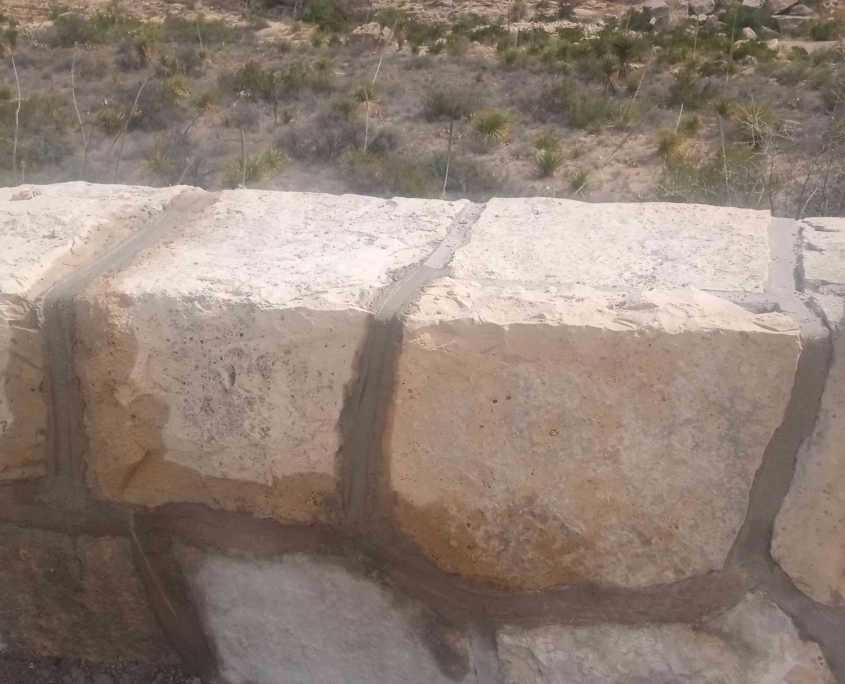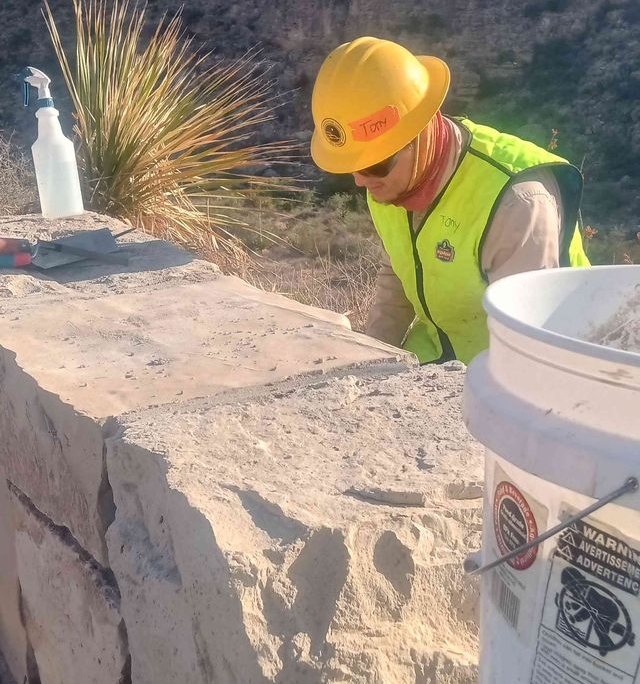By: Emma Fantuzzo
More than 80 years ago, members of the Civilian Conservation Corps (CCC) worked at Carlsbad Caverns National Park in New Mexico, building infrastructure that is still used by park visitors today. This past summer, a small crew of AmeriCorps members from Conservation Corps New Mexico served at the park and, under the guidance of a master mason, helped restore stone walls built by the CCC. Learn how this project – supported by the Great American Outdoors Act – helped the Carlsbad Caverns maintenance team, and helped inspire a new generation of park professionals.
About the Project:

Conservation Corps New Mexico Dry Masonry Crew
In 2023, The Corps Network’s Corps Project Assistance Team (CPAT) visited Carlsbad Caverns National Park to review maintenance projects where Corps could potentially help. Launched in 2022 with support from the National Park Foundation, the CPAT has traveled to nearly every region of the National Park Service, visiting small and medium-sized parks that often do not have the staff capacity to quickly address maintenance needs. It’s at these smaller parks that Corps can step in and make a particularly big impact. After the CPAT finishes a site visit, they develop a report detailing how and where Corps can support the park’s project needs. Based on these recommendations, the park then engages a Corps to complete the work. To date, parks have used funding from the Great American Outdoors Act Legacy Restoration Fund to partner with Corps to complete these critical maintenance projects.
Carlsbad Caverns National Park is located in the hot, arid, Guadalupe Mountains in southeastern New Mexico. Discovered by a teenage explorer in 1898, and later made a national park in 1930, the caverns have inspired generations of environmental stewards. In the late 1930s, the Civilian Conservation Corps (CCC) worked in the park to develop trails, facilities, landscaping, and more. This work has allowed almost 500,000 visitors to explore the park annually.
Unfortunately, with limited staff capacity and the availability of stone masons dwindling as many professionals in this field retire, the park faced a maintenance backlog. Some stone masonry projects have been on backlog since 2017. With the help of the CPAT team, Carlsbad Caverns partnered with Conservation Corps New Mexico (CCNM) to rebuild over 600 feet of historic stone guardrail under the guidance of a retired master stone mason, Bruce Wright. This work proved to be invaluable to the park and provided Corpsmembers with an experience in historic preservation that could help land them positions elsewhere.
Getting to Work:
While CCNM and Carlsbad have collaborated on trail work in the park before, this was the first time the Corps and park partnered on a masonry project. Through the National Park Service’s Experienced Services Program, Bruce Wright was identified to help mentor and oversee the Corpsmembers.
Together, the six-person Crew, including two Crew Leaders, worked with Bruce in 100+ degree heat. Historical stone masonry is hard work. Corpsmembers had to drill out old joints with a grinder; cut and reset stones; learn to mix concrete and work it into tiny crevices, and more. All of this was done primarily using tools similar to what the original builders would have used.

Completed Dry Masonry Wall
The guardrail was originally built over 80 years ago by the CCC. As they fixed the wall, Corpsmembers found mementos, including coins from the 1930s, that the original builders had left for future generations to find. To continue the tradition, the Corpsmembers left some of their own mementos in the new wall. These included little leaves, broken jewelry, and cupcake toppers.
While they worked, Corpsmembers gained a deeper appreciation for their predecessors.
“Bruce let us know that the original builders would not have had pre-mixed concrete…we had power tools,” said Liz…., a Corpsmember from CCNM.
Bruce was a huge help and inspiration for the Corpsmembers. Members mention that his high energy and eighties rock music kept them engaged. He made sure that all the Corpsmembers had the assistance they needed and was patient explaining all the intricacies of his craft.
During the project, the crew faced a few setbacks. The heat necessitated pausing work frequently for breaks to hydrate and cool off. One member had to go home due to illness. At one point, a car crashed into a section of wall that had been restored and the Crew had to rebuild it. Despite this, the Crew completed double the amount of work they originally projected doing.
Impact on Corpsmembers:

CCNM Dry Masonry Corpsmember
The Crew worked long days in high heat with little to no shade. They used a car’s air conditioning to cool off throughout the day. Corpsmember Liz says that the project taught her that she has more strength than she realized. Corpsmembers learned self-sufficiency while maintaining their own tools and looking out for one another. They felt they gained more self-confidence and were proud of the work that they did.
Carlsbad’s Facilities Maintenance Program Manager, Keenan Comer, who was closely involved in the day-to-day work says, “I hope Corpsmembers take away the importance of keeping historic trades alive and the importance of historic preservation.”
After the project, multiple Corpsmembers applied for positions with the Harpers Ferry National Historical Park to go into preservation trades.
As one member noted, “the job isn’t troubling, but it creates grit.”
Impact on the Park:
Carlsbad Caverns National Park has more stone masonry work that needs to be done, but as Keenan stated, “[The Corpsmembers] knocked out a huge chunk of work.”
For smaller, remote parks like Carlsbad, where staffing can sometimes be a challenge, having assistance from five to six individuals from a Corps is invaluable. As Keenan expressed, Corpsmembers are young and have energy and open minds. They provide extra hands to complete work, and – on a deeper level – the park service has an opportunity to engage a new generation of prospective resource management professionals. For this particular project, there was the opportunity to train people in the dying field of historic stone masonry, thus helping preserve a historic trade and keep history alive in our parks.

CCNM Dry Masonry Corpsmember





































































